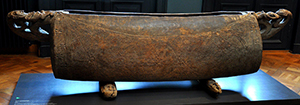

Earthly Things – Ghostly Matters
Damian Christinger
Damian Christinger (*1975, Zurich) studied Global Art History and Intercultural Studies. He works as an independent curator, writer, and lectures at different institutions on transcultural theory and practice in curating, the Anthropocene and indigenous knowledge.
He worked as a guest curator for the Museum Rietberg Zurich, 2014/2015, was the co-curator of the “Assembleia Mothertree”, 2018, in collaboration with Ernesto Neto, Fondation Beyeler, and Daniela Zyman. 2019 saw the opening of “A Ship Will Not Come”, an exhibition at the Johann Jacobs Museum in Zurich and a long-term research and collaboration with Roger M. Buergel and Adnan Softic. In 2020 he participated as a writer-in-residence for the exhibition “Tomorrow is an Island” at the ADM Gallery of the Nanyang Technological University as part of the Singapore Biennale. 2021/2022 he was the guest-curator for the first phase of Habitat, a space working on the interconnectedness of art and ecologies at Wyss Academy of Nature, Berne, Nairobi, Vientiane, and Lima. In October 2023 he co-curated the show “Spatial Solidarities” with Studio Other Spaces, Olafur Eliasson and Sebastian Behmann, examining the role of architecture, art, and design in sustainability at Das Gelbe Haus, Flims, and in December 2023 co-curated (with Ravi Agarwal) an exhibition titled “Time as a Mother” for the Serendipity Arts Festival in Goa. 2024 he curated “Fusiugnomias” at Casa d’Angel, Lumbrein, “Ancestral Futures” at Gallery Espace, Delhi, “there are tides in the body” at Emami Art/KCC, Kolkata, and “Ghosts in Machines” for the Serendipity Art Festival in Goa. In 2025 he invited artists from Ladakh to the Swiss valleys for “A River Runs From My Kitchen” at Fly, Susch, co-curated “Estranged Geographies” for Durbar Hall, Kerala and will extend it into a commissioned satellite show for the Kochi-Muziris Biennale 2025/26.
He is currently the curator at large for Shared Ecologies Archive/Space/Programs in Delhi, is responsible for the series “Folle Duree” for Espace Diaphanes in Berlin, Murano, and Zurich, and serves on the board of the Shyama Foundation, Delhi, the advisory board of Re-Source, the sustainability department of the University of the Arts, Zurich, and is a curatorial advisor for Bergen Assembly 2025, Norway.
Published essays include “Beyond Anthropology: Art, History and the Unbearable Longing for a Nondual Existence” in: Daniela Zyman: Ernsto Neto and the Huni Kuin: Aru Kuxipa/Sacred Secret, TBA21 Wien/Sternberg Press, 2016, „Eye to Eye – The Legacy of Paulo Freire“ in: Daniela Zyman: The Commissions Book, TBA21/Sternberg Press, Aug. 2020, „E você, quem é você» in: ZHdK and Fotomuseum Winterthur: Nachbilder. Eine Foto Text Anthologie, Spector Books, 2021, “A Memorial for a Harvest” in: Take on Art, Issue 28, December 2022, “Local Conversations on Alpine Futures” in: Studio Other Spaces: Spatial Solidarities. A Field Guide, 2023, “A Moment at the Fedacla” in: Christina Pestova-Ejikson: Along Unseen Rivers. Towards an Attentive Study of Urban Water, Pro Helvetia, 2024.
Damian Christinger (*1975, Zürich) studierte Globale Kunstgeschichte und Interkulturelle Studien. Er arbeitet als unabhängiger Kurator und Autor und hält an verschiedenen Institutionen Vorträge über transkulturelle Theorie und Praxis des Kuratierens, das Anthropozän und indigenes Wissen.
Er arbeitete als Gastkurator für das Museum Rietberg Zürich, 2014/2015, war Co-Kurator der "Assembleia Mothertree", 2018, in Zusammenarbeit mit Ernesto Neto, Fondation Beyeler, und Daniela Zyman. 2019 wurde die Ausstellung "A Ship Will Not Come" im Johann Jacobs Museum in Zürich eröffnet, eine langfristige Recherche und Zusammenarbeit mit Roger M. Buergel und Adnan Softic. Im Jahr 2020 nahm er als Writer-in-Residence an der Ausstellung "Tomorrow is an Island" in der ADM Gallery der Nanyang Technological University im Rahmen der Singapur Biennale teil. 2021/2022 war er Gastkurator für die erste Phase von Habitat, einem Raum, der sich mit der Verflechtung von Kunst und Ökologie in der Wyss Academy of Nature, Bern, Nairobi, Vientiane und Lima beschäftigt. Im Oktober 2023 war er Ko-Kurator der Ausstellung "Spatial Solidarities" mit Studio Other Spaces, Olafur Eliasson und Sebastian Behmann, die die Rolle von Architektur, Kunst und Design in der Nachhaltigkeit im Gelben Haus in Flims untersuchte, und im Dezember 2023 war er Ko-Kurator (mit Ravi Agarwal) einer Ausstellung mit dem Titel "Time as a Mother" für das Serendipity Arts Festival in Goa. 2024 kuratierte er "Fusiugnomias" in der Casa d'Angel, Lumbrein, "Ancestral Futures" in der Gallery Espace, Delhi, "there are tides in the body" bei Emami Art/KCC, Kolkata, und "Ghosts in Machines" für das Serendipity Art Festival in Goa. Im Jahr 2025 lud er Künstler aus Ladakh in die Schweizer Täler ein, um "A River Runs From My Kitchen" in Fly, Susch, zu zeigen. Er war Ko-Kurator von "Estranged Geographies" für Durbar Hall, Kerala, und wird diese Ausstellung zu einer Satellitenausstellung für die Kochi-Muziris Biennale 2025/26 ausbauen.
Zurzeit ist er Kurator für Shared Ecologies Archive/Space/Programs in Delhi, verantwortlich für die Serie "Folle Duree" für Espace Diaphanes in Berlin, Murano und Zürich, Mitglied des Vorstands der Shyama Foundation, Delhi, des Beirats von Re-Source, der Nachhaltigkeitsabteilung der Zürcher Hochschule der Künste, und kuratorischer Berater für Bergen Assembly 2025, Norwegen.
Zu den veröffentlichten Aufsätzen gehört "Beyond Anthropology: Kunst, Geschichte und die unerträgliche Sehnsucht nach einem nondualen Dasein" in: Daniela Zyman: Ernsto Neto und die Huni Kuin: Aru Kuxipa/Sacred Secret, TBA21 Wien/Sternberg Press, 2016, "Eye to Eye - The Legacy of Paulo Freire" in: Daniela Zyman: The Commissions Book, TBA21/Sternberg Press, Aug. 2020, "E você, quem é você" in: ZHdK und Fotomuseum Winterthur: Nachbilder. Eine Foto Text Anthologie, Spector Books, 2021, "A Memorial for a Harvest" in: Take on Art, Ausgabe 28, Dezember 2022, "Local Conversations on Alpine Futures" in: Studio Other Spaces: Räumliche Solidaritäten. A Field Guide, 2023, "A Moment at the Fedacla" in: Christina Pestova-Ejikson: Entlang ungesehener Flüsse. Auf dem Weg zu einer aufmerksamen Untersuchung des städtischen Wassers, Pro Helvetia, 2024.
Slit Drum, exhibited at Museum Rietberg, Zurich
In the program of the artist talks on Sunday, 21 September
14:00 Damian Christinger, To the Lighthouse. Objects in Time, Memory, and Reflections
To the Lighthouse: Objects in Time, Memory, and Reflections
Now that the broken promises of a Western modernity have become all too apparent through a post-colonial lens, it seems that certain works inhabiting the contemporary condition are animated from within by layers upon layers of unstable, shifting, tentative, other-languaged versions of a global reality. By experiencing these artworks, we understand that time and space do not coalesce. Time tends to move faster than space; The ghosts from the past are employed to haunt our futures.
We lack words for this disjunct between time and place. Virginia Woolf tried to describe it nonetheless. She writes of the incompatibility of space with time in her novel To the Lighthouse, where a house takes over the narrative. This talk will start with a slit drum on display at the Museum Rietberg, pay tribute to the Necronautical Society and veer into the oncoming lights of not only the lighthouse, but the reflections of literature and art.
To the Lighthouse: Objects in Time, Memory, and Reflections
Nun, da die gebrochenen Versprechen der westlichen Moderne aus postkolonialer Perspektive nur allzu offensichtlich geworden sind, scheint es, dass bestimmte Werke, die die zeitgenössische Situation bewohnen, von innen heraus von Schichten über Schichten instabiler, sich verschiebender, zaghafter, anderssprachiger Versionen einer globalen Realität belebt werden. Wenn wir diese Kunstwerke erleben, verstehen wir, dass Zeit und Raum nicht zusammenwachsen. Die Zeit neigt dazu, sich schneller zu bewegen als der Raum; die Geister der Vergangenheit werden eingesetzt, um unsere Zukunft heimzusuchen.
Uns fehlen die Worte für diese Trennung zwischen Zeit und Ort. Virginia Woolf hat dennoch versucht, sie zu beschreiben. In ihrem Roman To the Lighthouse schreibt sie über die Unvereinbarkeit von Raum und Zeit, wobei ein Haus die Erzählung dominiert. Dieser Vortrag beginnt mit einer im Museum Rietberg ausgestellten Schlitzflamm, würdigt die Necronautical Society und wendet sich dann nicht nur den Lichtern des Leuchtturms zu, sondern auch den Reflexionen in Literatur und Kunst.
